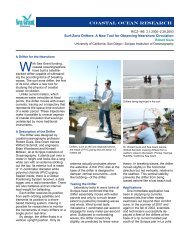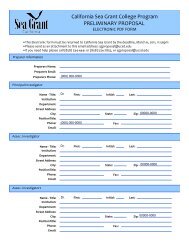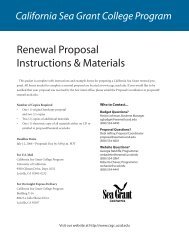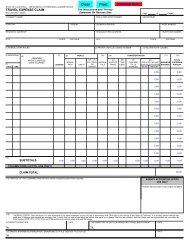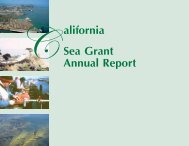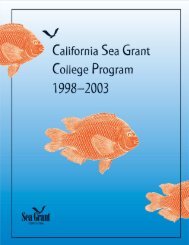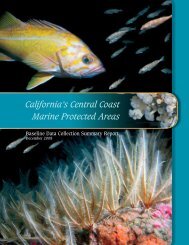Crescent City Profile - California Sea Grant
Crescent City Profile - California Sea Grant
Crescent City Profile - California Sea Grant
- No tags were found...
You also want an ePaper? Increase the reach of your titles
YUMPU automatically turns print PDFs into web optimized ePapers that Google loves.
The annual number of salmon trips averaged66 in recent years, a 92% decline from thelong-term average of 866 trips. Fishing effort,which exceeded 7,800 trips in 1981 and 1982,declined precipitously to 26 trips in 1985(when the <strong>California</strong> KMZ was closed). Effortrebounded to 708 trips in 1986, when theKMZ reopened, then continued its downwardtrajectory to 21 trips by 1991. Since 1992,effort has ranged from 0 to 178 trips per year,exceeding 100 in only two years (2002 and2004).Annual ex-vessel prices for salmon averaged$3.21 per pound in recent years, a modest 13%increase compared to the long-term averageof $2.83 per pound. From 1981 through 1993,prices varied from $2.51 to $4.31. From1995 through 2004, prices shifted downwardto $1.58–$2.91 per pound. After the fisheryclosure in 2006, prices peaked at $4.89 in2007.Salmon troll activity at <strong>Crescent</strong> <strong>City</strong> hasdeclined not only in absolute terms, but alsoas a proportion of total activity at the port.The proportion of vessels that participated inthe fishery averaged 37% over the long term,and 19% in recent years. Over these sameperiods, the salmon contribution to total tripsdeclined from 15% to 2%, the contribution tolandings remained unchanged at 1%, and thecontribution to landed value declined slightlyfrom 3% to 2%.and participation, and provided part of theincentive for the construction of a wastewatertreatment facility at the harbor. Since 2008,ocean shrimp trawl grounds in state watershave been closed between Point Reyes andFalse Cape (located south of Eureka). <strong>Crescent</strong><strong>City</strong> shrimp fishermen reported fishing south ofCape Mendocino (delivering to <strong>Crescent</strong> <strong>City</strong>,Eureka or Fort Bragg) many years in the past,as the resource was often more abundant andaccessible than in federal waters off <strong>Crescent</strong><strong>City</strong>.Shrimp landings exceeded three millionpounds in 1981 and 1982, declined abruptly asthe resource became scarce during the 1982–83El Niño, then expanded steadily to 6.5 millionpounds in 1987 (Figure 11, Table 11). Landingspeaked between 1988 and 1992, ranging from7.8 million to 17.3 million pounds. Landingsdeclined to 1.2–8.8 million pounds between1993 and 2002, then declined more abruptlyto 0–350,000 pounds between 2003 and 2007.Annual landings averaged 172,000 pounds inrecent years, 96% lower than the long-termaverage of 4.6 million pounds. Ex-vesselvalue followed a similar pattern, peaking at$5.5–$7.9 million between 1987 and 1992and reaching lows of $0–$172,000 duringthe period 2003–2007. Annual landed valueaveraged $78,700 in recent years, 97% lowerthan the long-term average of $3.1 million.The Ocean (Pink) Shrimp Trawl FisheryThe shrimp trawl fishery, managed by the statewith some federal oversight, 24 started alongthe North Coast in the 1950s, and expandedin the 1970s largely due to technologicalchanges in fishing (i.e., double-rig trawlnets) and processing (i.e., shrimp peelingmachines) (Frimodig et al. 2009). Although theshrimp trawl fishery has played a lesser roleat <strong>Crescent</strong> <strong>City</strong> in recent years, historicallyit accounted for substantial landings, value<strong>Crescent</strong> <strong>City</strong> Fishing Community <strong>Profile</strong> 27



